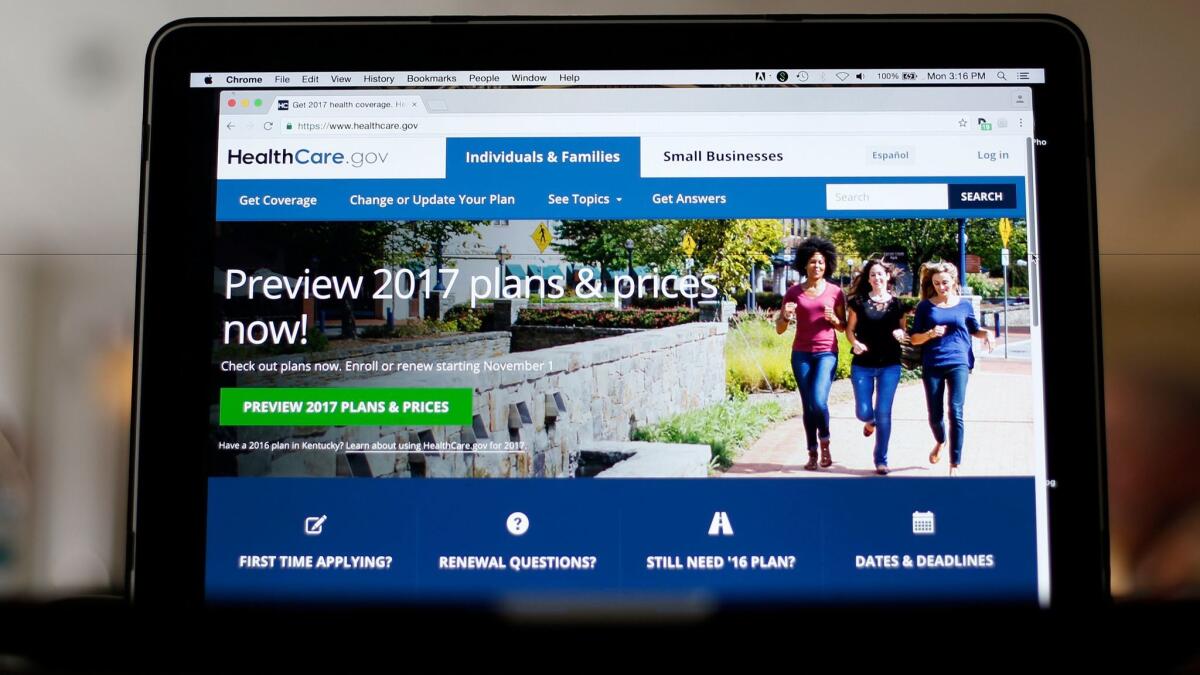Trump administration rolls out changes to Obamacare

- Share via
The Trump administration released limited fixes Thursday for shaky health insurance markets, even as it reaffirmed its goal of dismantling the Obama-era healthcare law that created them and that covers millions of Americans.
Republicans contend that the Affordable Care Act — also called the ACA or Obamacare — is beyond repair, but their “repeal and replace” slogan hasn’t been easy to put into practice, nor politically popular. So the administration is taking steps to keep the existing system going even as it pursues its ambition of a total remake.
Many of the changes announced Thursday follow recommendations from insurers, which wanted the government to address shortcomings with HealthCare.gov markets, including complaints that some people are gaming the system by signing up only when they get sick and then dropping out after being treated.
But the White House remained mum on the biggest concern. Insurers, doctors, hospitals and the business community have asked President Trump to preserve ACA “cost-sharing” subsidies that pare down high deductibles and copayments for consumers with modest incomes. Those subsidies are separate from the better-known premium subsidies that most customers receive.
The future of the cost-sharing subsidies, estimated at $7 billion this year, is under a legal cloud. Without them, experts say, the government marketplaces that provide subsidized private insurance for about 12 million people will be overwhelmed by premium increases and insurer departures.
In a Wall Street Journal interview this week, Trump raised the possibility of shutting off the money if Democrats won’t bargain on healthcare. But the president also said he hasn’t made up his mind yet, and said he doesn’t want people to get hurt. House Democratic Leader Nancy Pelosi of California called that an “appalling threat” and said Trump is trying to “manufacture a crisis.” The new administration has continued to make cost-sharing payments to insurers as it weighs options.
The changes announced Thursday include:
• A shortened sign-up window of 45 days, starting with coverage for 2018. That’s about half as long as the current open-enrollment season. Some insurers say a tighter sign-up schedule will allow for more focused marketing. Consumer advocates are worried uninsured people may be left out.
• Curbs on “special enrollment periods” that allow consumers to sign up outside the normal open-enrollment window. Insurers say these have been too easily granted, allowing some people to sign up only when they need costly treatment.
• Allowing an insurer to collect past debt for unpaid premiums from the previous 12 months before applying a consumer’s payments to a new policy.
• Giving insurers more flexibility to design low-premium plans that can be tailored to young adults.
“While these steps will help stabilize the individual and small-group markets, they are not a long-term cure for the problems that the Affordable Care Act has created in our healthcare system,” Seema Verma, the Trump administration official responsible for the markets, said in a statement.
The changes come as insurers are figuring out their plans for 2018.
Americans probably won’t know for certain what sort of choices they will have until late summer or early fall, a couple of months before open enrollment begins.
This year saw premium increases averaging 25% for a standard plan in states served by HealthCare.gov. Some insurers say they’ve lost hundreds of millions of dollars, and many have pulled back or are considering doing so.
Most communities will have competing insurers on the public marketplace next year, but a growing number will be down to one, and some areas may have none.
Humana said it would leave the marketplaces next year, a decision that would leave 16 counties in Tennessee with no insurers selling HealthCare.gov coverage.
Aetna and Wellmark Blue Cross and Blue Shield have announced they’ll leave Iowa’s individual insurance market.
All eyes are now on Anthem, a big Blue Cross-Blue Shield insurer operating in several states that has yet to announce its intentions. Chief Executive Joseph Swedish has said his company would not commit to participating next year. Swedish and other insurance officials have said the government must stabilize the marketplaces.
Dave Dillon of the Society of Actuaries says growth in underlying medical expenses could drive coverage prices up 10% or more.
Nonetheless, the nonpartisan Congressional Budget Office says the ACA markets will be stable next year in most areas.
In Washington, Republicans are trying to resolve an impasse between hardliners and moderates that has prevented them from getting their own healthcare bill through the House.
Meanwhile, the legal issue over the cost-sharing subsidies also remains in limbo. A U.S. District judge found that Congress did not specifically authorize the payments, making the expenditure unconstitutional. The case is on hold. Congress could approve the money, but that would be a politically difficult vote for Republicans.
ALSO
United apologizes — again — after attorney describes dragged passenger’s injuries
Uber accused of using a secret program called Hell to track Lyft drivers
Bacteria infected 10 infants at UC Irvine hospital, but the public is just finding out
More to Read
Inside the business of entertainment
The Wide Shot brings you news, analysis and insights on everything from streaming wars to production — and what it all means for the future.
You may occasionally receive promotional content from the Los Angeles Times.










